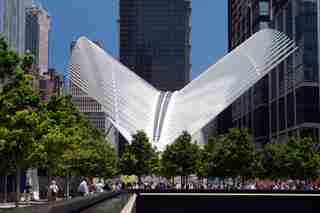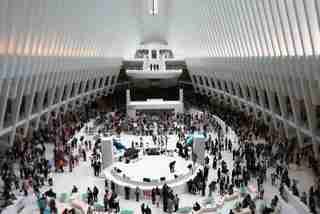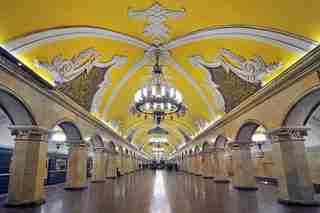The World’s Most Beautiful Train Stations
Whether it’s on your daily commute or daring adventures across the globe, some of the world’s most stunning architecture can be found in train stations. From the spectacular Gothic Revival architecture of London’s St. Pancras International , to the Art Deco and Spanish Colonial style of John and Donald Parkinson’s Los Angeles Union Station, to the undulating roof resting on Melbourne’s Southern Cross Station, the dramatic design featured in these transportation hubs makes catching a train an awe-inspiring experience. Next time you find yourself booking a worldly adventure, make sure to plan a stop at any one of these renowned stations.

World Trade Center Transportation Hub, New York
Architect Santiago Calatrava ’s highly anticipated World Trade Center Transportation Hub opened in March in Lower Manhattan. The centerpiece of the project is the 800,000-square-foot glass-and-steel structure known as the Oculus.

World Trade Center Transportation Hub, New York
The hub connects 11 subway lines, the PATH train, the Battery Park City Ferry Terminal, and several downtown buildings. The soaring main hall features white marble floors and a 355-foot retractable skylight. The Oculus is also now home to the 365,000-square-foot Westfield World Trade Center mall, which opened in August.

Metro Station Komsomolskaya, Moscow
Joseph Stalin oversaw the construction of this baroque "palace for the people," which was completed in 1952 only a year before he died. The platform of the Moscow subway station pictured here has 68 limestone-and-marble pillars rising from a granite floor. Lining its sunflower-yellow ceiling are glittering mosaic panels decorated with smalt (cobalt glass ground into pigment) and precious stones, each mural paying tribute to a historic Russian military triumph. A decade after Stalin—and such opulence—had fallen out of favor, his images in two panels were removed, and the party line turned to "kilometers at the expense of architecture," an ideology favoring function over form.
Gare du Nord, Paris
Opened in 1864, this majestic Beaux Arts complex in Paris’s 10th arrondissement is one of the oldest rail stations in the world, still one of the busiest, and perhaps the most magnificent. Twenty-three female statues adorn its façade, each personifying a destination served by the rail line.
Gare du Nord, Paris
The station’s interior is bathed in natural light thanks to soaring windows, and the train shed’s glass-and-cast-iron roof is a triumphant merger of engineering and beauty.
Kuala Lumpur Railway Station, Kuala Lumpur, Malaysia
Designed by a British government architect named Arthur Benison Hubback and opened in 1910, the Kuala Lumpur station is a neo-Moorish delight, a fantastical agglomeration of minarets, dome-capped pavilions, and articulated archways. Now more of a hub for commuters than tourists, the magnificent white-and-cream Anglo-Asian station is still worth a stop.
Rotterdam Centraal Station, Rotterdam, Netherlands
Like many older cities with outmoded train stations, Rotterdam needed its central rail hub to accommodate more passengers as well as high-speed and commuter lines. Rather than preserve a nondescript 1957 terminal, the city commissioned a team of architectural firms to collaborate on a new complex, which opened in March of this year. The centerpiece of the design is the main entrance’s shiny boomerang-like canopy, a stainless-steel projection that is warmed by a partial cladding of wood. A similar melding of cool and warm materials occurs at the train platforms, where a transparent roof is supported by wood beams. Less visible, but no less impressive, is the use of 130,000 solar cells spread across the roof area, making this one of the largest rooftop solar projects in Europe.
Kanazawa Station, Ishikawa, Japan
When Kanazawa’s 1898 station was upgraded in 2005, initial reactions were mixed. The addition of the ultramodern glass-and-steel dome and giant drum-shaped wood gate struck many as ill-fitting. But visitors continue to flock to the station's dramatic add-ons, and the new structures’ allure competes handily with the historic town’s other attractions, including a geisha district and former samurai quarters.
Union Station, Washington, D.C.
This Beaux Arts wonder, completed in 1907, was was the first major structure in the country to be built of Bethel, Vermont, white granite, a stone prized for its strength and brightness. The station brought the city’s two rail hubs under one roof, allowing the railroads to dismantle central trackwork and create the National Mall.
Union Station, Washington, D.C.
The station itself, designed by architect Daniel H. Burnham, features a stunning coffered plaster ceiling and draws inspiration from classical elements such as Rome’s Arch of Constantine (reflected in the main façade) and Baths of Diocletian (seen in the vaulted interiors). Surface embellishments make liberal use of marble, gold leaf, and mahogany.
CFM Railway Station, Maputo, Mozambique
The bronze dome of Maputo’s central rail station cuts an impressive silhouette against the uncluttered skyline that surrounds it. A high-water mark of Portuguese colonial architecture—built by Alfredo Augusto Lisboa de Lima, Mário Veiga, and Ferreira da Costa and completed in 1916—the station overlooks Praça dos Trabalhadores (Workers’ Square). The modestly handsome structure features a mint-green-and-white exterior, wrought-iron latticework, and a display of antique steam locomotives.
King’s Cross Station, London
The historic section of King’s Cross was designed by architect Lewis Cubitt and completed in 1852. At the time, its two train sheds’ glass roofs were considered cutting-edge, although their laminated-timber beams were replaced with steel girders, and their two platforms and 14 tracks quickly fell short of demand. A new edge has been honed with a 15-year, $650-million renovation project that has as its most prominent feature this new concourse designed by John McAslan. Covering a new ticket hall and pedestrian thoroughfare, the enormous single-span structure, a sweeping steel grid that looks a bit like a bisected funnel, opened in time for the 2012 Olympics.
Liège-Guillemins Railway Station, Liège, Belgium
Spanish architect Santiago Calatrava designed the latest incarnation of this rail station using steel, glass, and white concrete. His version, completed in 2009, replaces a 1958 International Style building (which itself replaced an 1842 Beaux Arts structure), intentionally lacks a single façade in order to unite two neighborhoods previously separated by the railroad tracks. Calatrava’s interest in the plasticity of concrete is evident here, and the immense ribbed vault he created flows organically, suggesting a wave breaking over the thousands of passengers that flow under it daily.
Estación de Atocha, Madrid
The original 1851 Atocha station was mostly destroyed by fire and was replaced in 1892 with a shed that features a soaring wrought-iron-and-glass inverted-hull roof (almost 90 feet high) connecting two brick flanks. The architect for the project, Alberto de Palacio Elissagne, also built palaces and bridges, and on this project collaborated with Alexandre-Gustave Eiffel, who had just finished his eponymous Parisian tower. Atocha continues to serve as Spain’s largest train station, but in 1992 its main hall was transformed into a shopping mall centered by a one-acre tropical garden.
Chhatrapati Shivaji Terminus, Mumbai, India
Formerly known as Victoria Terminus Station, the Chhatrapati Shivaji Terminus is a mash-up of Victorian Italianate Gothic Revival and traditional Indian architecture. Designed to serve the country’s leading mercantile port and completed in 1888, the station took ten years to build, with tremendous labor involved in executing architect F. W. Stevens’s plan for decorative stone carvings and statuary of local flora and fauna, gargoyles, allegorical grotesques, and busts representing the country’s castes and communities.
Chhatrapati Shivaji Terminus, Mumbai, India
The station has been designated a UNESCO World Heritage Site in recognition of its many flourishes, including an octagonal ribbed masonry dome with steel windows, and its exuberant palette of materials that includes indigenous malad stone, Italian marble, polished granite, limestone, and Burmese teak.
Milano Centrale, Milan
Italy’s second-largest station (after Rome’s Stazione Termini) opened in 1931. It was originally modeled after Union Station in Washington, D.C., but when Mussolini came into power, he expanded the Beaux Arts design to include elements of Art Nouveau and Art Deco. The stunning results feature 118,000 square feet of marble flooring, an array of muscular stone sculptures, and five train sheds covered with vast iron-and-glass canopies.
São Bento Railway Station, Porto, Portugal
Architect José Marques da Silva turned to 19th-century Paris for inspiration when he designed the stone façade and mansard roof of this station, which opened in 1916 in Portugal’s second largest city.
São Bento Railway Station, Porto, Portugal
São Bento Railway Station, Porto, Portugal The station’s centerpiece was created by the painter and native son Jorge Colaço, who covered the atrium walls with scenes from Portugal’s history. Although Colaço often worked on canvas, the technique used here enlisted 20,000 tin-glazed ceramic tiles. It took the artist 11 years to complete the murals.
Grand Central Terminal, New York
The original Grand Central was built by transportation magnate Cornelius Vanderbilt in 1871, but that building was demolished in 1903. The current iteration, completed in 1913, continues to be a jewel in New York’s architectural crown. Its vast concourse is distinguished by elegant marble staircases at either end and a four-faced milk-glass-and-brass clock above its central information booth; the painted zodiac constellations on its cavernous domed ceiling, meanwhile, were almost completely obscured by cigarette-smoke damage until a 1998 restoration. Other highlights of the terminal include the Tiffany clock on its 42nd Street façade and the landmark subterranean Oyster Bar restaurant, which features a serpentine lunch counter, a whispering gallery in its entryway arch, and terra-cotta Guastavino tiles lining its vaulted ceiling.
Hungerburg Station, Innsbruck, Austria (Hybrid Funicular)
Architect Zaha Hadid first made her mark on Austria’s Innsbruck region with the 2002 Bergisel ski-jump tower. She returned with this design for the Nordpark Cable Railway, a four-station funicular line that replaced a 100-year-old tram and transports passengers up a vertiginous incline for 1.1 miles. Each of Hadid’s stations is capped with swooping glass shapes that suggest ice floes and snowdrifts. Here, a view of Hungerburg Station, the final stop in the funicular’s ascent which was completed in 2007.
Sirkeci Railway Station, Istanbul
As Istanbul’s gateway to Europe, the magnificent Sirkeci station was appropriately a melding of French Art Nouveau and Ottoman aesthetics. When it opened in 1890, it was considered quite modern for its time, boasting 300 gas lanterns and tile stoves imported from Austria.
Sirkeci Railway Station, Istanbul
The station, which stands at the foot of the Bosporus Strait, features bands of bricks across its façade, clock towers, and stained-glass windows. The station served as the terminus for the famed Orient Express, which connected Paris’s Gare de l’Est to Turkey in an 80-hour journey, until the line stopped serving Istanbul in 1977.
Antwerpen-Centraal Station, Antwerp, Belgium
The glorious waiting hall of the Antwerp station, completed in 1905, is lavishly adorned with more than 20 kinds of marble and stone, but what keeps this from feeling ponderous is the counterpoint of soaring arched windows and skylights that fill the concourse with light. The upper train platform, too, features a magnificent vaulted iron-and-glass roof.
Antwerpen-Centraal Station, Antwerp, Belgium
Thanks to a careful 2009 restoration, dilapidated pediments and turrets that were removed in the 1950s have been reconstructed, and the integrity of the original terminal has been maintained even as new tunnels have been dug to allow for through traffic and high-speed rail.
Haydarpaşa Railway Station, Istanbul
Less famous—but no less grand—than Istanbul’s Sirkeci station, Haydarpaşa has the distinction of being built on land reclaimed from the Bosporus Strait, which leaves it surrounded by water on three sides. The imposing neoclassical edifice, designed by German architects Otto Ritter and Helmut Conu, was inaugurated in 1909 on the birthday of the reigning sultan, Mehmed V.
Haydarpaşa Railway Station, Istanbul
The station’s concourse features coffered barrel-vault ceilings and generous windows. While Haydarpaşa closed in 2012 for restoration and the development of high-speed lines, it’s still an impressive sight from the exterior, best viewed by boat.
Southern Cross Station, Melbourne
Stretching an entire city block, Melbourne’s elaborate station features an undulating roof that rests on a series of Y-shaped columns. The structure was renovated in 2005 (and renamed—it was previously known as Spencer Street Station, for its location) and now displays an innovative design by Grimshaw Architects.
Amsterdam Centraal Station, Amsterdam
Amsterdam’s neo-Renaissance station is the largest railway station in the European Union, serving over 260,000 passengers each day, having opened to the public in 1889. Designed by Dutch architect Pierre Cuypers, the Gothic-style terminal features a cast-iron platform room.
Union Station, Los Angeles
Father-son architects John and Donald Parkinson blended Spanish Colonial and Art Deco styles for Los Angeles’s main railway station, completed in 1939, which is the largest passenger train terminal in the western U.S. Patios line the walls of the station’s waiting room, while travertine marble covers the station’s interior walls on the lower level.